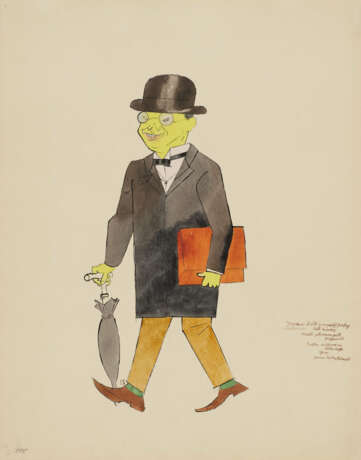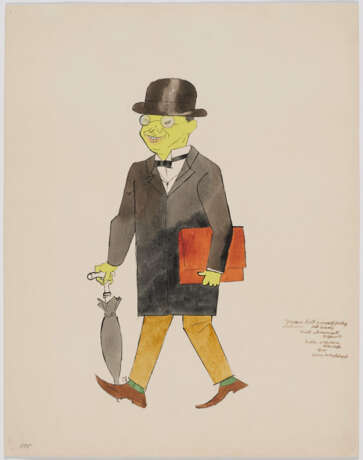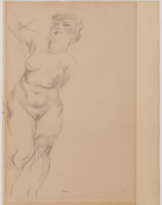ID 1405944
Lot 104 | George Grosz. Japaner (Figurine)
Estimate value
€ 15 000 – 20 000
Title: Japaner (Figurine).
Date: Around 1923.
Technique: Pencil, India ink and watercolour on strong vellum.
Measurement: 50 x 39.5cm.
Notation: Estate stamp verso lower left with the inscribed no.: UC 381 6.
Frame/Pedestal: Framed.
We have received confirmation of this work from Mr. Ralph Jentsch, Berlin, dated 8 March 2025. The work will be included in the catalogue raisonné of works on paper currently in preparation.
Provenance:
- Atelier des Künstlers, Berlin
- Estate of George Grosz, 1959
- Galerie Herbert Meyer-Ellinger, Frankfurt a.M.
- Bayer AG, Leverkusen (acquired from the previous owner in 1979)
Exhibitions:
- Galerie Rolf Ohse, Bremen 1978
- Frankfurter Kunstkabinett Hanna Bekker vom Rath, Frankfurt a.M. 1978
Literature:
- Exhib. cat. George Grosz. 1893-1959. Einhundert Zeichnungen und Aquarelle aus den Jahren 1912-1942, Bremen 1978, p. 59, fig.
- Exhib. cat. George Grosz. 1893-1959. Ölbilder, Aquarelle, Zeichnungen und Druckgraphik, Frankfurt a.M. 1978, cat. rais. no. 46
- Powerful drawing by one of the most important modern artists
- Characteristic combination of precise lines, nuanced coloring and satirical exaggeration
- Created at the height of his artistic career
Grosz' kritische Auseinandersetzung mit der Gesellschaft
Der Maler und Grafiker George Grosz prägte mit seinem Oeuvre maßgeblich das kritische Bild einer Gesellschaft im Umbruch der 1920er Jahre. Die Abgründe der Weimarer Republik interessierten ihn ebenso wie politische Konflikte und karikaturhafte Verzerrungen. Dabei widmete sich Grosz nicht nur dem Expressionismus und Dadaismus, sondern ebenfalls der Neuen Sachlichkeit und dem Verismus. Seine unverwechselbare Satire und anklagende Kraft behält er jedoch stilübergreifend bei. Geprägt von scharfen Konturen, einer expressiven Farbgebung und einer schonungslosen Überzeichnung entsteht auch "Japaner (Figurine)" in einem für Grosz entscheidenden Jahr. 1923 veröffentlichte er seine herausragende Sammelmappe "Ecce Homo" ("Siehe, der Mensch"): Ein Agglomerat aus gesellschaftskritischen Druckgrafiken, für die ihm später vor Gericht der Prozess gemacht wurde. Dennoch arbeitete Grosz unbeirrt weiter und entwickelte konsequent eine unverwechselbare Bildsprache.
"Japaner (Figurine)" als Ausdruck der Metropole
Die Tusche- und Aquarell-Zeichnung "Japaner (Figurine)" vereint die für Grosz typischen Stilelemente jener satirischen Überspitzung auf eine eindrucksvolle Weise. Er zeichnet einen Mann, ausgestattet mit einem Mantel, Melonenhut, Stockschirm und Aktenmappe, der sich aufgrund des Titels und der Physiognomie als Japaner identifizieren lässt. Die Darstellung zeugt von Grosz' virtuosem Umgang mit Linie und Fläche, mit der er seine Figuren oft karikierend, aber stets präzise charakterisierte. Die Wahl des Motivs ist möglichweise auf seinen Wohnort Berlin zurückzuführen. Die pulsierende Metropole der Weimarer Republik und ihre kulturellen Einflüsse bedeuteten für Grosz einen fruchtbaren Nährboden. Die Zeichnung steht somit exemplarisch für Grosz' Fähigkeit, mit wenigen Linien und gezielten Farbakzenten unverkennbare Typen zu erschaffen, die das urbane Berliner Treiben scharfsinnig aufgreifen.
George Grosz und das Theater
Ein wesentlicher Teil dieses großstädtischen Lebens stellte das Theater dar, das auf Grosz eine starke Faszination ausübte. Während seiner Karriere als Künstler entwarf er Kostüme für das Theater und wirkte an zahlreichen Produktionen mit, unter anderem für Bertolt Brecht, Arnold Zweig und Carl Sternheim. Auch "Japaner (Figurine)" entstand als Entwurf eines Kostümdesigns. Für die Premiere von Georg Kaisers Volksstück "Nebeneinander" im Berliner Lustspielhaus entwarf Grosz 1923 die Kostüme der Schauspieler sowie die Bühnenausstattung. Mit größter Sorgfalt widmete er sich der Charaktergestaltung. Daher besitzt die Zeichnung des Japaners einen eigenständigen künstlerischen Wert, der über eine bloße Entwurfsskizze hinausgeht.
| Artist: | George Grosz (1893 - 1959) |
|---|---|
| Applied technique: | Pencil |
| Auction house category: | Modern paintings, drawings, watercolours |
| Artist: | George Grosz (1893 - 1959) |
|---|---|
| Applied technique: | Pencil |
| Auction house category: | Modern paintings, drawings, watercolours |
| Address of auction |
VAN HAM Kunstauktionen GmbH Hitzelerstr. 2 50968 Köln Germany | ||||||||||||||
|---|---|---|---|---|---|---|---|---|---|---|---|---|---|---|---|
| Preview | |||||||||||||||
| Phone | +49 221 92586215 | ||||||||||||||
| Fax | +49 221 92 58 62 4 | ||||||||||||||
| Buyer Premium | 32% | ||||||||||||||
| Conditions of purchase | Conditions of purchase | ||||||||||||||
| Business hours | Business hours
|
More from Creator
Related terms
- George Grosz (1893 - 1959)
- Pencil
- 1920er
- 1920s
- Classic Photographs
- Deutschland
- Expressionismus
- Figur / Figuren
- Figure / Figures
- George Grosz
- Germany
- Klassische Fotografie
-
Mischtechnik
-
Mixed media
- Modern Art
- Neue Sachlichkeit
- New Objectivity
- Papierarbeit
- Rahmen
- Unikate
- Works on paper
- framed
- Modern paintings, drawings, watercolours














